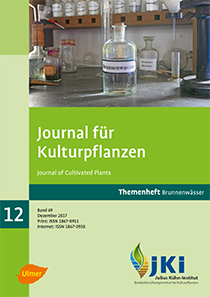Elemental composition of German well waters: Part 1 – Significance of the geological origin
DOI:
https://doi.org/10.5073/JfK.2017.12.01Keywords:
Stratigraphic classification, geological age of aquifers, well water, water quality, major and trace elementsAbstract
Classifications group items according to common characteristics into categories. For well waters, these are in particular characteristics of stratigraphic and hydrogeological origin, and hydrogeochemical typecast. It was the objective of this study to analyse if additional information on the elemental composition of well waters can be derived from their stratigraphic classification. Through knowing the geological origin of well water this would allow to infer its elemental composition without having to conduct laborious and costly analyses. The basis of this study is a database of elementary compositions of 637 German well waters maintained by the Institute for Crop and Soil Science, Julius Kuehn-Institut in Braunschweig. Out of the 67 elements which were determined in 637 well water samples, 22 elements showed statistically significant differences in their concentration across stratigraphic categories. More than half of the elements with elevated concentrations (above the mean values of the analysed data set) the elements Be, Cs, Er, F, Ge, Lu, Mo, Sb, Si, Tm, U, Yb and HCO3– were found in geologically older rocks, namely those from wells of paleozoic/proterozoic aquifer age. In the youngest waters of aquifers of the Tertiary and Quaternary elemental concentrations proved to be neither particularly high, nor low. Thus using certain well waters for irrigation will add essential macro- and micro-nutrients such as Ca, Cl, Cu, Fe, K, Mg, Mn, Mo, P, S and Zn, beneficial elements such as Si, Na and lanthanides, and potentially toxic elements like Cd, Pb and U to soils. For waters from geologically old aquifers it is therefore recommended to calculate associated loads in order to assess element-specifically effects on plants, soils and groundwater.
Downloads
Published
Issue
Section
License
The content of the journal is licensed under the Creative Commons Attribution 4.0 License. Any user is free to share and adapt (remix, transform, build upon) the content as long as the original publication is attributed (authors, title, year, journal, issue, pages).
The copyright of the published work remains with the authors. The authors grant the Journal of Cultivated Plants, the Julius Kühn-Institut and the OpenAgrar repository the non-exclusive right to distribute and exploit the work.







